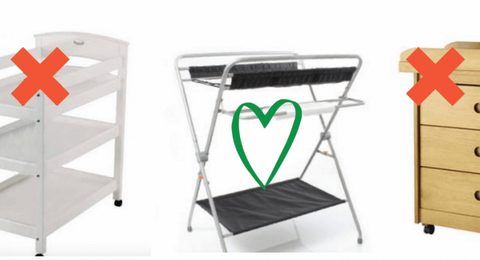
There is no Australian Standard for change tables, so it’s important that we carefully consider the safety features of any change tables we are offered before trying to rehome it. We often have to say “no thank you” to donors with a change table to offer, and this blog post is designed to explain why.
Lack of space
A change table is a piece of furniture designed specifically for changing a baby's nappy at a comfortable height for the carer. It allows you to place your baby at a height where you can change a nappy with maximum convenience.
For most of the families we support it is a long way down the list of priorities and need. For many, especially those living in refuges or crisis accommodation, they have no room for a cot - let alone a change table.
Folding change tables are preferred as they can be collapsed and take up less space.
The potential for injury
A quarter of childhood injuries in the home are as a result of a fall from nursery furniture. Serious injuries can happen when a baby rolls to the side and falls off the change table. Falls can occur in babies as young as three months. Head injuries are the most common injury, with many babies requiring hospital admission.
Babies falling up to 1.5 metres to the floor or onto another piece of furniture can suffer serious injuries, concussion and fractures. Three tier change tables have the additional risk of older siblings climbing up them, especially models with pull-out trays that can act as steps or unbalance the table.
Roll off protection
For this reason we can only rehome a folding change table if it has sides of more than 10cm higher than the level of the foam mat, or a safety strap that does up over baby’s tummy. Folding change tables are preferred as they can be collapsed and take up less space. Three tier change tables have the additional risk of older siblings climbing up them, especially models with pull-out trays that can act as steps or unbalance the table.
Change tables with casters should have at least 2 casters that lock, and these should always be locked when the table is in use.
The floor is the safest place to change a baby
It is far safer for the adult to get down to the child’s level. If your back and knees allow, you can eliminate falling hazards altogether by changing your baby at floor level using a towel or change mat placed in a clean, dry area. This is the preference of many of the families we support, and the recommendation of the maternal child and health nurses and social workers we partner with.
There are four main types of change table, and Eureka Mums can only rehome the first type.
- Portable folding tables with a metal frame and fabric body.
- Wooden tables with two or three tiers.
- Chest of drawers with change table attachment on top.
- Tables that include a baby bath under the change surface.

A popular combination is the bath and change table in one. In our experience these tend to be very lightweight and made of aluminium and plastic, which becomes brittle with age. Sadly many of them have damage to the foam cover on top and this is not something we can repair (see photo above).
Another popular furniture item is the combination of the change table and chest of drawers. We do not rehome large furniture like chest of drawers as they are too big and heavy to transport for donors, volunteers and social workers alike. We do not rehome the wooden change tables that sit on top of chest of drawers either as we have no way of ensuring that the family receiving has the correct piece of furniture to place it on. (This is the same reason why we do not rehome portable highchairs).
There is nothing to prevent you from trying to sell these items on ebay or give them away on Gumtree etc, just so long as you can supply the instructions for safe use and can explain to the new owner how they can be used safely. As for the bath/change table combination with the damaged foam - that is best taken to your local transfer or recycling station or hard rubbish.
Change table safety tips:
The higher the fall the greater risk of injury so one hand should always be placed on baby while using a change table
It takes a split second for a child to roll off a change table so make sure all the clothes, wipes, nappies and other gear you need are within arm’s reach before you lay your baby on the change table.
Even if there is a harness strap, never leave a child alone on a change table
Teach older children to keep off the change table.
Make sure you don’t overload the side pouches.
If you have any feedback, questions or comments, please email safety@eurekamums.org.
Thanks to Choice Magazine, KidsSafe and Raising Children Network.

